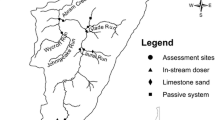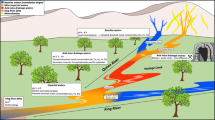Abstract
Hewett Fork in Raccoon Creek, Ohio was a large source of acid mine drainage (AMD) to the main stem of Raccoon Creek, impacting the biological community for several kilometers. To reduce this impact, the AMD treatment was implemented in the Hewett Fork subwatershed to treat water from the largest mine drainage source in the watershed near the village of Carbondale. From prior to installation of wetland treatment in 2000 and installation of the lime doser in 2004, the pH of the mine discharge has been raised from about 4 to about 9, which greatly improved biological communities in Hewett Fork and Raccoon Creek. During the summer of 2010, the doser was off-line for approximately 2 weeks. While the chemistry of Hewett Fork showed little lasting change due to non-treatment, biological surveys show the effect of temporary non-treatment. In the year and a half since the doser was off-line, surveys have shown that the fish community was seriously impacted due to non-treatment and it has not yet recovered; the macroinvertebrate community, on the other hand, showed little impact due to non-treatment, and has shown no lasting effect of non-treatment.
Zusammenfassung
Hewett Fork am Raccoon Creek, Ohio, war eine bedeutende Austrittstelle sauren Grubenwassers in den Hauptstrom des Raccoon Creek, der die Artengemeinschaft auf mehreren Kilometern beeinträchtigte. Um diese Belastung zu reduzieren, wurde eine Grubenwasseraufbereitung im Einzugsgebiet des Hewett Fork installiert. Diese reinigt das Grubenwasser der größten Austrittstelle im Wassereinzugsgebiet nahe dem Dorf Carbondale. Bevor im Jahr 2000 ein konstruiertes Feuchtgebiet errichtet wurde, wies das Grubenwasser einen pH Wert von 4 auf. Nachdem im Jahr 2004 zusätzlich eine Kalkdosierung installiert wurde, stiegt der pH zwischenzeitlich auf 9 an. Dies hatte zur Folge, dass die Artengemeinschaft im Hewett Fork und Raccoon Creek deutlich verbessert wurde. Im Verlauf des Sommers 2010 war die Dosierungsanlage circa 2 Wochen außer Betrieb. Während sich der Chemismus im Hewett Fork durch die Nichtbehandlung nur geringfügig veränderte, zeigen biologische Erhebungen die Auswirkungen der vorübergehenden Nichtbehandlung. Wie diese Untersuchungen belegen, wurde die Fischgemeinschaft in den 1 ½ Jahren seit der Nichtbehandlung durch den Ausfall des Kalkdosierers ernsthaft beeinträchtigt und hat sich bislang nicht erholt. Andererseits hatte die Nichtbehandlung auf die Makroinvertebratengemeinschaft nur eine geringe Auswirkung und sie zeigte dadurch keinen bleibenden Schaden.
Resumen
Hewett Fork en Raccoon Creek, Ohio fue una gran fuente de drenaje ácido de mina (AMD), impactando la comunidad biológica por muchos kilómetros. Para reducir este impacto, se implementó el tratamiento del AMD fue implementado en la subcuenca Hewett Fork para tratar agua proveniente de la mayor fuente de drenaje de mina en la cuenca cerca de la villa de Carbondale. Desde la instalación de un tratamiento wetland en 2000 y la instalación de un dosificador de lima en 2004, el pH de la descarga de la mina ha sido elevado desde 4 hasta 9 lo cual mejoró significativamente las comunidades biológicas en Hewett Fork y Raccoon Creek. Durante el verano de 2010, el dosificador estuvo inactivo por aproximadamente 2 semanas. Mientras la química de Hewett Fork mostró un cambio apenas perdurable debido al no tratamiento, los estudios biológicos mostraron el efecto del detenimiento temporario del tratamiento. En el año y medio desde que el dosificador está inactivo, los estudios han mostrado que la comunidad ictícola fue seriamente impactada debido al no tratamiento y aun no ha sido recuperada; la comunidad macroinvertebrada, por otro lado, muestra un pequeño impacto y no ha mostrado ningún efecto perdurable debido al no tratamiento.
抽象
Hewett岔口 (Hewett Fork)向干流河道俄亥俄州浣熊溪(Raccoon Creek)排放大量酸性矿井水(AMD)而影响了数公里范围内的河道生物群落。为了减少此影响,在Hewett 岔口(Hewett Fork)子流域内处理来自Carbondale村附近的最大酸性矿井水水源。自2000年湿地处理系统安装之前至2004年石灰投放系统安装期间,矿井水pH值已经从4左右升高到9左右,大大改善了Hewett 岔口(Hewett Fork) 和浣熊溪(Raccoon Creek)的生物群落。2010年夏,投放系统短时间中断石灰投放约两周。虽然Hewett 岔口(Hewett Fork)水化学特性未因此发生明显变化,却对河流生物群落产生了遗留影响。在投放系统短时处理中断的一年半之后,调查显示鱼类受短时间处理中断影响最大而且还未完全恢复,而大型无脊椎动物受影响较小且无明显遗留影响。.







Similar content being viewed by others
References
Allard M, Moreau G (1987) Effects of experimental acidification on a lotic macroinvertebrate community. Hydrobiologia 144:37–49
Bell HL (1971) Effect of low pH on the survival and emergence of aquatic insects. Water Res 5:313–319
Bernard DP, Neill WE, Rowe L (1990) Impact of mild experimental acidification on short term invertebrate drift in a sensitive British Columbia stream. Hydrobiologia 203:63–72
Cairns JJ, Crossman JS, Dickson KL, Herricks EE (1971) The recovery of damaged streams. ASB Bull 18(3):79–106
Churchel MA, Batzer DP (2006) Recovery of aquatic macroinvertebrate communities from drought in Georgia Piedmont headwater streams. Am Midl Nat 156:259–272
Courtney LA, Clements WH (1998) Effects of acidic pH on benthic macroinvertebrate communities in stream microcosms. Hydrobiologia 379:135–145
Driscoll CT, Schecher WD (1990) The chemistry of aluminium in the environment. Environ Geochem Hlth 12(1):28–49
Fritz KM, Dodds WK (2004) Resistance and resilience of macroinvertebrate assemblages to drying and flood in a tallgrass prairie stream system. Hydrobiologia 527(1):99–112
Fuchs U, Statzner B (1990) Time scales for the recovery potential of river communities after restoration: lessons to be learned from smaller streams. River Res Appl 5(1):77–87
Gjerløv C, Hildrew AG, Jones JI (2003) Mobility of stream invertebrates in relation to disturbance and refugia: a test of habitat templet theory. J N Am Benthol Soc 22(2):207–223
Gostomski F (1990) The toxicity of aluminium to aquatic species in the US. Environ Geochem Hlth 12(1):51–54
Hall RJ, Likens GE, Fiance SB, Hendry GR (1980) Experimental acidification of a stream in the Hubbard Brook Experimental Forest, New Hampshire. Ecology 61:976–989
Hopkins PS, Kratz KW, Cooper SD (1989) Effects of an experimental acid pulse on invertebrates in a high altitude Sierra Nevada stream. Hydrobiologia 171:45–58
Johnson KS (2009) Performance of a family-level macroinvertebrate index (MAIS) for assessing acid mine impacts on streams in the Western Allegheny Plateau. Final report for ohio department of natural resources. Ohio University, Athens
Karr JR (1981) Assessment of biotic integrity using fish communities. Fisheries 6(6):21–27
Kowalik RA, Cooper DM, Evans CD, Ormerod SJ (2007) Acidic episodes retard the biological recovery of upland British streams from chronic acidification. Glob Change Biol 13(11):1365–2486
Kratz KW, Cooper SD, Melack JM (1994) Effects of single and repeated experimental acid pulses on invertebrates in a high altitude Sierra Nevada stream. Freshwater Biol 32:161–183
Nelson SM, Roline RA (1996) Recovery of a stream macroinvertebrate community from mine drainage disturbance. Hydrobiologia 339(1–3):73–84
NPS (2009) 2009 NPS report—Raccoon Creek Watershed—Carbondale II Doser. Non-point source monitoring system.http://www.watersheddata.com. Accessed Nov 30 2011
Ohio Environmental Protection Agency (1988) Biological criteria for the protection of aquatic life: users manual for biological field assessment of Ohio surface waters. Ecological Assessment Section, Division of Water Quality, vol II, Columbus
Ohio Environmental Protection Agency (1997) Biological and water quality study of the Raccoon Creek basin (1995). OEPA technical report MAS/1996-12-7, Ecological Assessment Unit, Division of Surface Water, Columbus
Ohio Environmental Protection Agency (2002) Total maximum daily loads for the upper raccoon creek final report. Division of Surface Water, Ohio Environmental Protection Agency, Columbus
Ohio Environmental Protection Agency (2007) Water use designations and statewide criteria. OEPA Rule 3745-1-07, Columbus
Rice C, Hoy JB, Hoy R, Last J, Farley M, Grow J, Knapp M, Simon K (2002) Acid mine drainage abatement and treatment (AMDAT) plan for the headwaters of the Raccoon Creek watershed. Raccoon Creek Partnership, Athens
Richards C, Minshall GW (1992) Spatial and temporal trends in stream macroinvertebrate communities: the influence of catchment disturbance. Hydrobiologia 241(3):173–194
Rosemond AD, Reice SR, Elwood JW, Mulholland PJ (1992) The effects of stream acidity on benthic invertebrate communities in the south-eastern United States. Freshwater Biol 27:193–209
Smith EP, Voshell JR (1997) Studies of benthic macroinvertebrates and fish in streams within EPA Region 3 for development of biological indicators of ecological condition, part 1, benthic macroinvertebrates. Report to US EPA, Cooperative Agreement CF821462010. USEPA, Washington
Sutcliff DW, Carrick TR (1973) Studies on the mountain streams of the English Lake District, I. pH, calcium and the distribution of invertebrates in the River Duddon. Freshwater Biol 3:437–462
Vuori KM (1995) Species- and population-specific responses of translocated hydropsychid larvae (Trichoptera, Hydropsychidae) to runoff from acid sulphate soils in the river Kyronjoki, Western Finland. Freshwater Biol 33:305–318
Wallace JB (1990) Recovery of lotic macroinvertebrate communities from disturbance. Environ Manage 14(5):605–620
Weatherly NS, Ormerod SJ (1991) The importance of acid episodes in determining faunal distributions in Welsh streams. Freshwater Biol 25:71–84
Zische JA, Arthur JW, Nordlie KJ et al (1983) Acidification effects on macro invertebrates and fathead minnows (Pimephales promelas) in outdoor experimental channels. Water Res 17:47–63
Acknowledgments
This work was supported by a foundation grant from American Electric Power and by the Ohio Department of Natural Resources Division of Mineral Resources Managment.
Author information
Authors and Affiliations
Corresponding author
Rights and permissions
About this article
Cite this article
Kruse, N.A., Bowman, J.R., Mackey, A.L. et al. The Lasting Impacts of Offline Periods in Lime Dosed Streams: A Case Study in Raccoon Creek, Ohio. Mine Water Environ 31, 266–272 (2012). https://doi.org/10.1007/s10230-012-0194-4
Received:
Accepted:
Published:
Issue Date:
DOI: https://doi.org/10.1007/s10230-012-0194-4




